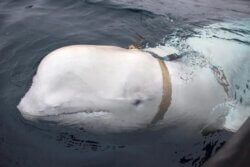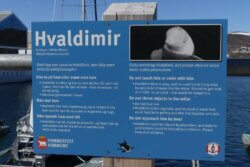In April 2019, reports began circulating about a solitary beluga whale who had shown up off the coast of Norway and was frequently approaching fishing boats. He was wearing a leather harness with a camera mount and with the words “Equipment St. Petersburg” on the buckle. So, it seemed likely that the whale was a military conscript from the Russian navy who had somehow gone AWOL. (To this day, the Russian military has never commented.)

Photo of Hvaldimir with his harness by Jorgen Ree Wiig, Sea Surveillance Service
When one of the fishermen got into the water, the 14-foot, 2,700-pound whale allowed him to remove the harness, and then followed another boat back to the harbor of the nearby fishing and tourism town of Hammerfest.
Soon named Hvaldimir – a conflation of the Norwegian word for whale and the Russian name Vladimir – the beluga quickly attracted the attention of scientists and government officials trying to figure out what was best for him, along with tourists from far and wide who wanted to be photographed with him.
Over the four years since then, many plans have been proposed for Hvaldimir’s future. They include relocating him further north to where there are many more ocean-going belugas; creating a sanctuary for him by netting off a fjord in Norway; and simply leaving him be.
“Caught in a tangle of conflicting human emotions, some noble, others misguided, nearly all distorted by inadequate understanding.”Much has also been written about him, but perhaps the most insightful article to date comes from the pen of Ferris Jabr, author of the forthcoming book Becoming Earth: How Our Planet Came to Life. His article was published in The New York Times Magazine on January 15th, 2024.
Jabr notes that Hvaldimir finds himself increasingly “at the center of a dispute over his welfare … caught in a tangle of conflicting human emotions, some noble, others misguided, nearly all distorted by inadequate understanding.”
Whether captured from the wild or raised in captivity, he writes, captive whales are subject to “a heavy physical and psychological toll.” They are “in-between creatures: born to whales but raised by humans, not quite domesticated but no longer wild, suspended somewhere in the middle of instinct and compliance.” And while, or perhaps because, we view them with such awe, we also feel the need both to dominate them and to be recognized, even loved, by them. Not surprisingly, the end result is rarely, if ever, good for the whales.

Sign asking people not to touch Hvaldimir, nor swim with him, nor throw objects into the water, nor approach him by boat. Photo by DiFronzo via-creative-commons.
The same is also the case for many other kinds of animals. Caught up in our conflicted emotions toward these megafauna, we humans tend to project onto them our own desires for how we wish they would relate to us. But as Henry Beston famously wrote a hundred years ago: “In a world older and more complete than ours … they are not brethren, they are not underlings; they are other Nations, caught with ourselves in the net of life and time.”
Although he was a captive whale, Hvaldimir differs from most other captive cetaceans in that he is accustomed to being in the ocean. Most captive whales were born in captivity and have never learned how to survive in the ocean. And Jabr notes that in recent years, scientists, conservationists and a few of the most progressive marine entertainment parks and aquariums have been working to establish sanctuaries to which the animals can be retired.
One problem they face, he writes, is that an ideal cetacean sanctuary “should be sheltered but still part of the ocean; it should be large, remote and untrafficked, yet still small and accessible enough to staff and manage. In other words, exactly the kind of place that humans like to keep for themselves.”
This is, of course, why it took the Whale Sanctuary Project three years of searching before we were able to select Port Hilford Bay, Nova Scotia, as our choice of location. And we were most fortunate in that when the community of nearby Sherbrooke heard about our work, they reached out to suggest that their region might be exactly what we were looking for. We have been met with a heartfelt welcome there.
Authentic sanctuaries remain the best option for captive whales and dolphins, as has already proven to be the case for land-based megafauna. And we look to a time when cetaceans are no longer being captured from the ocean, nor bred in captivity, and when those now in captivity can be retired to sanctuaries where they can live their lives in an environment that’s as close as possible to a life in the open ocean.
Meanwhile, Hvaldimir’s future remains unclear. Other than for a few months when he strayed too far south, he has been able to feed and look after himself. And the best option for him may well be to leave him alone as long as that continues to be the case and without getting into any other kind of trouble.
Jabr writes that “we have often expressed our passion for such creatures by trying to possess them: by fitting them with collars, roping them into circuses and placing them behind glass … Yet the closer we have pulled such animals toward us, the more difficult it has become to deny the torment that our proximity inflicts.
“Perhaps the purest act of love,” he concludes, “is to leave them alone in the first place.”
# # #